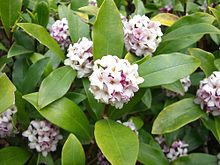| Daphne odora | |
|---|---|

| |
|
Scientific classification
| |
| Kingdom: | Plantae |
| Clade: | Tracheophytes |
| Clade: | Angiosperms |
| Clade: | Eudicots |
| Clade: | Rosids |
| Order: | Malvales |
| Family: | Thymelaeaceae |
| Genus: | Daphne |
| Species: | D. odora
|
| Binomial name | |
| Daphne odora | |
Daphne odora, winter daphne, is a species of flowering plant in the family Thymelaeaceae, native to China, later spread to Japan and Korea. It is an evergreen shrub, grown for its very fragrant, fleshy, pale-pink, tubular flowers, each with four spreading lobes, and for its glossy foliage. It rarely fruits, producing red berries after flowering.
The Latin specific epithet odora means "fragrant". [2] In Korea, the plant is also poetically called "chullihyang" – a thousand-mile scent – referring to the delightful fragrance of the flowers. In Japan, the plant is more commonly known as " jinchōge".
It grows best in fertile, slightly acid, peaty, well-drained soils. It grows in full sun or partial shade, and is hardy to −10 °C (14 °F), possibly lower.
Plants are not long lived, usually lasting eight to ten years. [3] Daphne generally do not react well to root disturbance, and may transplant badly. D. odora is also susceptible to virus infection, which causes leaf mottling. [4]
All parts of the plant are poisonous to humans and to a range of domestic animals. [5] Some people experience dermatitis from contact with the sap. [6]
Daphne odora may be propagated by semi-ripe cuttings in summer.
Cultivars
- D. odora f. rosacea has white and pink flowers.
- D. odora f. rubra has dark red-pink flowers with reduced fragrance.
- D. odora 'Aureomarginata' has yellow edged leaves, and is hardier and more suitable to cultivation than the plain-leaved forms. [4]
References
- ^ "Daphne odora". The Plant List. Retrieved 2017-11-19.
- ^ Harrison, Lorraine (2012). RHS Latin for gardeners. United Kingdom: Mitchell Beazley. p. 224. ISBN 9781845337315.
- ^ Flora, The Gardener's Bible, ABC Publishing, Sydney, 2005
- ^ a b The Reader's Digest Gardeners' Encyclopaedia of Plants & Flowers, Sydney, 1998
- ^ "Poison Plant Illustrations - Australian Plant Information".
- ^ Royal Horticultural Society